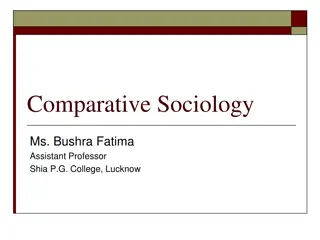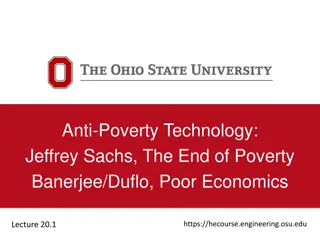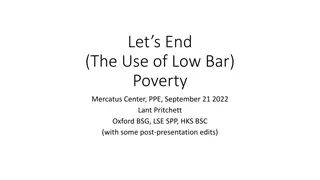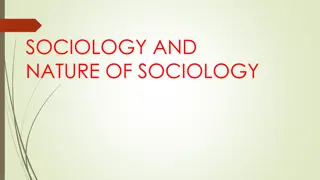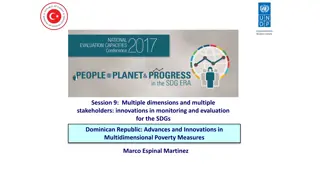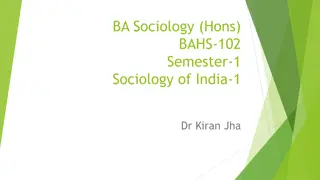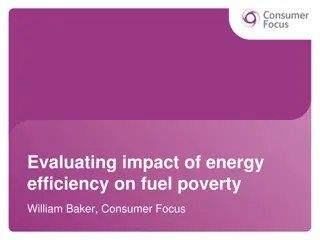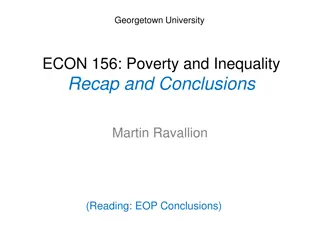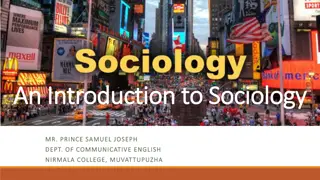Talking about Poverty in A2 Sociology Wales 2018
This content provides insights into a specific section of the A2 Sociology examination in Wales 2018, focusing on discussing poverty. It includes information on the assessment criteria, sample questions, and tips for success. The content also offers an example of a marking sheet and guidance for self-assessment. Moreover, it outlines the key stages and considerations in designing a research project related to social networking sites, highlighting common problems that researchers may encounter.
Download Presentation

Please find below an Image/Link to download the presentation.
The content on the website is provided AS IS for your information and personal use only. It may not be sold, licensed, or shared on other websites without obtaining consent from the author.If you encounter any issues during the download, it is possible that the publisher has removed the file from their server.
You are allowed to download the files provided on this website for personal or commercial use, subject to the condition that they are used lawfully. All files are the property of their respective owners.
The content on the website is provided AS IS for your information and personal use only. It may not be sold, licensed, or shared on other websites without obtaining consent from the author.
E N D
Presentation Transcript
A2 Sociology Wales 2018 Unit 4
Compulsory Section A Talking about poverty 1a: This question is still a problem for some candidates Success in this question depended on the degree to which candidates were able to demonstrate their understanding of the research context and aims because doing this this effectively enabled them to offer methodologically sound suggestions. Generic strengths of the method/ technique/approach did not get into the top mark band. However, selection of appropriate strengths and application of these to the aims of the research is the best approach. The best answers focused on the qualitative nature of the method and the sensitive nature of the research topic. Gaining the trust of the gang members was crucial to the collection of valid data. Method allowed this.
This is an example of a mark sheet for 1a which could be used for AfL SOCIOLOGY A2 Unit 4 Student Feedback & Self Assessment Sheet Name: Form: Date: a) Knowledge (AO1) AO1 Knowledge will be detailed with 2 methodologically sound reasons clearly identified. There must be a clear link to the context for one reason to get into this band. 4 Some knowledge of the reasons. 2 reasons with less detail or one detailed. 2-3 1 No relevant Knowledge displayed AO2 Understanding will be detailed with 2 reasons clearly explained with reference to key methodological concepts. Both points will be contextualised for full marks. There must be a clear link to the context for one reason to get into this band. 5-6 Some understanding of the reasons. 2 reasons with some explanation for both. One reason may be linked to the context. At the bottom there may be no context. 3-4 1-2 No relevant Knowledge displayed /10
1b You have been asked to design a research project to collect data on the role that social networking sites play in the lives of a sample of people in your area. Outline each stage of your design explaining the reasons for your choice at each stage Identify some of the problems that might occur and the impact that these might have on the quality of the data collected Common problems: Sampling very often done badly, using impractical suggestions or not addressed at all. Justifications were not contextualised which produced generic, one size fits all designs. Problems and their impact on the quality of the data were often forgotten and this prevented the candidate from getting into top band. Lack of technical language. These problems persist in spite of the feedback and advice offered.
As long as the design is contextualised it can follow a framework such as this The design What? Why? Context/ grover What problems? What impact ?(link to GROVER) 1. Operationalise key terms 2. Select the method 3. Consider any ethical considerations with either the focus of the research or the sample (BSA guide) 4. Identify sample/target population Will you use a sample frame? What sampling technique? 5. Pilot study? 6. How will you actually do the research? Practical considerations such as time and cost 7. Analysis of results
Read the following answer. Check whether the candidate has followed the instructions in the brief. Assess the essay using the mark sheet in your pack.
Before I start my research, I must first operationalise the key terms in the brief so that I am able to identify the relevant people for my sample for young boys, I mean all 11 18 year old boys by area, I mean using the local school to get a representative sample of boys attitudes to education. I have used my local school because I am able to access it easily and I am able to access boys aged 11 18 as I can use time in school to collect the data needed. The method that I am going to use to collect qualitative data is unstructured interviews. I have chosen this method because I believe that it would put the interviewees at ease because it is more of a chat. This can help me because if the interviewee knows that they can be comfortable then they may be more inclined to tell the truth. This would make the data more valid because if the interviewee tells the truth then I am able to receive rich, detailed results in which I would be able to analyse my data from. However by using unstructured interviews, the interviewee may go off the subject which may affect my objectivity, however, this could also give me data that I wasn t expecting to receive which can give me a better view of their attitudes and experiences in education. I will actually do the unstructured interviews in registration time after I have obtained the consent of the Headteacher. With consent, I will use an empty classroom where I can hold the interview which would last around 15 minutes for each interviewee. I have chosen to do the research in an empty classroom because it will allow me to engage with the interviewee and make them as comfortable as possible. There are some ethical considerations that I will have to look at before I do the research, one of which is that I would make sure that the interviewee is allowed to withdraw from the researcher at any time. The interviewee would also know that all of the findings from the interview would be kept confidentially and that nobody else will see it because it could be a sensitive subject. Additionally, an ethical issue that I would have to consider is that no interviewee would come to harm because of the research and I would overcome this by ensuring that the interviewees are able to remain anonymous.
The sampling technique that I am going to use is random sampling. I have chosen the technique because it allows everybody in the sample population to have a chance at being selected to take part in the research. I would obtain lists of every ?? from years 7 13 to be my sample population. I would then randomly chose 2 boys from each year in order to obtain my sample frame and this would give me the qualitative data that I need. I have chosen to use a sample frame because it gives me a list of a certain number of boys from the sample population so that I can obtain my data. I chose to use a small amount of boys for my sample because to collect qualitative data, it would take a while for each interview to collect detailed results. I have also chosen to do a pilot study before I carry out the actual research. I chose to use a pilot study because I will be able to make sure that any problems with the interview are sorted out. I would take a small number of boys aged 11-18 and do a pilot study with them. I would make sure that the environment they are in is suitable by asking if the venue of using a classroom would be suitable for the research. If not I could easily change it so that the real interviewees are relaxed. This is important because the venue plays a big part in the research because if the interviewee is uncomfortable then they may not wish to tell the truth. The problem with using the empty classroom is because of the topic in that the interviewees may not want to say anything bad about the education because they are in a classroom. However, I would ensure that the interviewer knows that what they say is going to be kept confidentially. There are also some practical considerations that I have to check to ensure that they do not cause problems for example, time and cost. When doing the pilot study and all the other consideration and preparations, I have to make sure it doesn t take up too much time. This is important because if I had a time limit then I wouldn t be able to spend a lot of time going through the preparations beforehand. However, because I have chosen to do unstructured interviews then this won t take much time to prepare as there are no questions to prepare for. Another consideration is cost; some pieces of research can be really expensive which I would need to ensure my research doesn t. I have chosen unstructured interviews and this wouldn t take up a huge amount of money to do because there is no more structure. I would analyse my results by using graphs. Once I have obtained the final data then I would compile it all into a graph where I am able to see the attitudes of boys to education clearly.
Ensuring success in all questions Candidates must have a clear understanding of the success criteria. They need to have a clear understanding of what the question/ statement demands Their answers must be focussed on this. So if they are asked to evaluate they must do so. AO2 and AO3 skills were often very weak; this will be addressed today.
An example of mark sheet for 2a/3a a) K &U (AO1) 9-10 Knowledge of the evidence described will be detailed ,wide ranging and accurate. 2 areas of the specification will be referred to. Appropriate sociological terminology will be used. At least 2 pieces of appropriate evidence will be offered for each area. 6-8 Some evidence will be described but there will be either fewer points made or those made will lack detail so that the answer has either depth or breadth. At least one piece of evidence for each area will be described. 3-5 Basic knowledge will be displayed through a smaller and more basic range of points. Evidence is likely to be anecdotal rather than empirical; examples rather than evidence. 1-2 Limited knowledge with a number of inaccuracies or misunderstanding. 0 No relevant material. Analysis (AO2) 9-10 Detailed explanations of the relevance of the evidence/ examples and knowledge are directly applied to the question. Answers in this band will present appropriate evidence. 6-8 Some explanations of the relevance of the evidence will be offered and some knowledge is applied to the question but this is more likely to be implicit. The evidence/ examples may be less relevant. 3-5 Analysis of the evidence described is basic, may be merely descriptive or assertive and superficial. At the lower end analysis is bordering on limited.(difficult to find). Examples rather than evidence. 1-2 Very limited if any analysis with limited reference to relevant studies or evidence. 0 No relevant material. /20
2a/3a QUESTIONS These questions require candidates to produce evidence of inequality. Many candidates examined difference rather than inequality and this needs to be addressed. The application of appropriate knowledge is important here. So, if the candidate had decided to answer the 2a question on gender inequality , they might have chosen family as an area where there is evidence of this inequality. There is a lot of up to date research that could be utilized but most people will be aware of the following pieces of evidence that could be used to answer half of the task. They obviously need to explain their choice of evidence; how it demonstrates gender inequality. They are not required to say why the inequality exists.
Gender inequalities in the Family Domestic Labour: A Legal and General study conducted in 2000 discovered that full time working mothers spent 56 hours per week on housework and childcare compared to 31 hours spent by men on these tasks. Duncombe and Marsden suggested that women bear the brunt of domestic and emotion work in families. This dual burden means that women spend considerable time soothing the emotions of children and partners creating what Duncombe and Marsden call a dual burden for women. Indeed they go further to suggest that as more and more women remain in full time employment after having children they experience a triple shift of paid work, domestic labour, and emotion work. Dryden claims that women continue to have the major responsibility for housework and childcare and In the same vein Speakman and Marchington suggest that men feign ignorance or incompetency using household machinery as a way of getting out of household tasks. Decision making: In 1980 Edgell suggested that middle class wives were likely to defer to their husbands in decision making. He said that this was particularly evident where important decisions were being made such as moving house or buying a new car. Jan Pahl s research corroborates Edgell s findings. Pahl suggests that in money management even in situations where it might appear that the woman control finances, her decisions are almost always beneficial to the man. Warrin et al (1999) suggest that in 95 Rochdale familes studied the vast majority continued to see the male as breadwinner. Violence in Families: Sclater (2000) suggests that violence and inequalities in power can be demonstrated through, threats, verbal abuse and psychological intimidation as well as the more obvious physical violence such as punching and kicking. Stanko( 2000) suggests that of all reported violent acts one third is committed by men on their female partners. Stanko claims that one incident of domestic violence against women is reported to police every minute. Similar studies such as Nazroo s 1999 research and Mirrlees-Black 1999 research maintain that women are more likely than men to suffer domestic abuse at the hands of their partner.
Section B This section concentrates on social inequality. There were two questions to choose from. Candidates are instructed to answer parts a and b from their chosen question. Knowledge and application of evidence of inequality is examined in part a. Knowledge, understanding and evaluation of sociological theories of social inequality are examined in part b.
Section B essays Evaluation remains the biggest hurdle to candidates achieving high marks for these essays. The whole task is about debating whether an explanation is correct. To do this most effectively, the use of evidence should be encouraged as a tool to assist judgements. Have a look at this essay and decide what you think. Gender inequality can be defined by many different themes and by sociologists such as feminist Shulamith Firestone who argues that it is the sexual class system that causes inequality because men control society with patriarchal dominance. They are able to exploit women and keep them inferior. Because women have babies, breastfeed and menstruate and this makes them dependent on men. It could be argued that this dependence causes inequality. It would be a good idea to examine some evidence here; perhaps work and pay with reference to horizontal segregation and vertical segregation then speculate about the link between this inequalities and what radical feminists say. This would provide an opportunity for AO2 and AO3] Ortner had a similar view believing that as women are closer to nature and men closer to culture in a patriarchal society where culture is superior to nature women become oppressed. This oppression can be seen in Saudi Arabia where women have very restricted rights like not being allowed to drive cars. Ortner suggests that culture legitimises the oppression of women. Relevance ? Linked to debate?
Functionalists such as Durkheim however would criticise this explanation of gender inequality as he would argue that there is a value consensus within society and that inequality is therefore positive as it is generally agreed that women should earn less money and take the mother role in order to maintain society. Therefore this idea of Ortner of legitimised inequality is wrong as if the whole of society accepts that some form of inequality is functional for society then surely it cannot be a bad thing. This comment relates to whether gender inequality is right not whether the explanation is better to have said: if functionalists are right and gender inequality is part of culture and is functional then functionalists are right. However, many women today continue to work after having children but because of the gender expectations placed on them regarding child care they find themselves unable to pursue high ranking jobs or their jobs are so low paid it isn t financially sensible to go back to work. If this is so what functionalists say is redundant and not very helpful in explaining gender inequality. A Marxist named Engels [never write like this] would argue that gender inequality from way back in the past where through monogamous marriage men would try to control women s sexuality in order to have control over who would inherit their property and wealth, namely their legitimate son. Women were exploited because they were tied to the man and under his control. Marxists also say that working class men take out the frustration and exploitation that they experience at work on their wives. The problem with Engels ideas is that they were theoretical and not proven with evidence. What are your thoughts on this paragraph? Ann Oakley offers another explanation of gender inequality. She says that as factory acts made it illegal for women and children to work in factories this forced them into domestic roles in the home and segregated roles with women tied to the private sphere of life. However it seems that gender inequality dates back much further and even since women have gained more rights and have moved into the workplace gender inequality continues. Marxists would argue that women experience class inequality and this is the real source of all inequality and it is true that rich upper class women appear less oppressed. And this one? What advice would you give on how to improve these paragraphs?
Liberal feminists focus their explanation of gender inequality on primary socialisation during which girls learn to be carers and home centred so to them equality will only be achieved with radical social reform backed by changes in the law. These views could be challenged because there has been some degree of social reform and some laws have been passed to support this and yet gender inequality still exists. For example the Equal Pay Act was supposed to ensure equal pay and it does for the same work but even today women earn on average 83% of what men earn. This is because they tend to do stereotypically female jobs that tend to pay less so perhaps socialisation still has a way to go. Many people claim that there is a glass ceiling in the workplace, an invisible barrier that women find it difficult to breakthough. In conclusion there are many different sociological explanations for gender inequality with feminists arguing that patriarchy is the reason and functionalists saying that it is inevitable and functional. Marxists say that gender inequality is just a smoke screen for the real basis for inequality and that is social class and until we have a classless society gender inequality will remain. What is good What is not good What does it need?
Part b questions Teachers are advised to use the new marking grids to engage in whole class marking exercises to assess exemplar essays or anonymised students essays. This has been a successful strategy for raising attainment. Points to remember: Essays must avoid being descriptive accounts of theory. Where the command requires candidates to evaluate a view they must interrogate it, not describe it or argue only in support of the view. Evidence should be used effectively to enhance well supported discussion and evaluation. Higher order skills should be developed to ensure improved performance. Common problems this year Descriptive accounts of theories which usually meant that candidates could not score more than bottom of band 3 for AO3. Any evidence used [and this was rare] was not used to argue. Skills [especially AO3] are weak.
For further information, please contact the subject officer at the WJEC Joanna Lewis Subject Officer 02920 265 167 GCESociology@wjec.co.uk Eira Morgan Subject Support Officer 02920 265 183 GCESociology@wjec.co.uk



